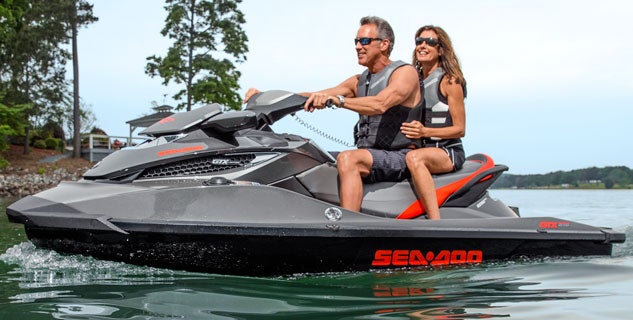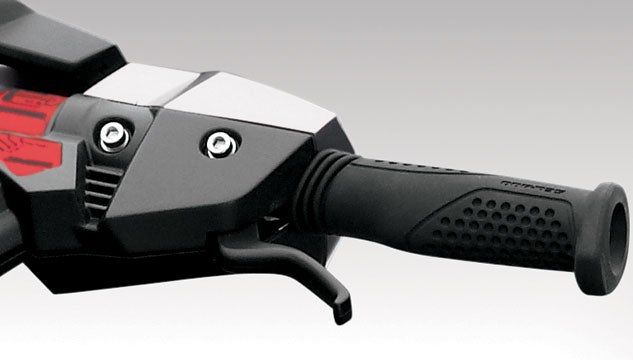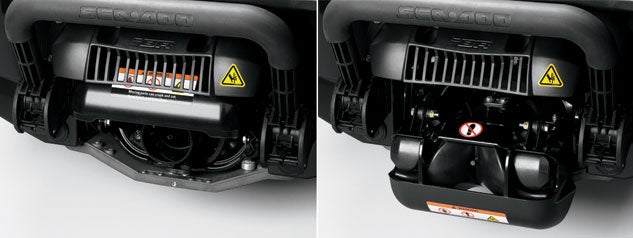Sea-Doo Intelligent Brake & Reverse Explained -Video
An in depth look at how iBR works
It’s a given that any Sea-Doo review of the past several years has included a brief explanation of the brand’s Intelligent Brake & Reverse technology. But as the saying goes, a picture is worth a thousand words. A video? Maybe even more.
So, for all of you who have longed for a more visual representation of the system, or just wanted an up-close look at what goes on behind the scenes that’s impossible to view inside the confines of the pump or below the waterline, here’s a little more in-depth view.
Words…and video…to help explain one of the most unique technologies in the personal watercraft market to date.
 You know that squeezing the iBR lever will help slow you down. Now it’s time to learn how it all works.
You know that squeezing the iBR lever will help slow you down. Now it’s time to learn how it all works.Hitting The Brakes
A brake is a novel idea in a boat of any kind. As boaters, we’re used to coasting to a stop rather than applying a force to halt our momentum. Sea-Doo broke from this convention with the introduction of Intelligent Brake & Reverse, or as it’s commonly called, iBR.
Get the Flash Player to see this player. |
As the video shows, the system takes full advantage of the electronic brains of the engine to link a modified reverse bucket to a combination brake-and-reverse lever mounted on the left side of the handlebars. That handlebar-mounted lever is instantly familiar to anyone who has ridden a motorcycle, bicycle, ATV or snowmobile. One distinct advantage to a lever on the handlebars is that it allows a driver to keep his eyes focused on the water ahead, rather than looking down for a handle integrated into the console.
 Sea-Doo’s handlebar-mounted iBR lever allows riders to keep their eyes focussed on the water.
Sea-Doo’s handlebar-mounted iBR lever allows riders to keep their eyes focussed on the water.As a rider squeezes the brake lever, several things happen in a fraction of a second. First, that computer brain detects the rider input and overrides throttle input, just long enough to interrupt the thrust and allow the reverse/brake bucket to swing down into position, its lowest edge about two inches below the hull. Next, a controlled amount of that thrust is then reapplied so that it hits the bucket and is redirected forward to provide stopping power. It’s a trick riders used to try to do manually, but at speed one that could have dangerous consequences. Sea-Doo avoids this scenario by limiting the amount of thrust that gets reapplied. In short, no one gets launched over the handlebars. The braking bucket is also designed to pull the craft from the back, keeping the stern planted in the water and preventing the nose from submarining.
 Before squeezing the iBR lever, the brake/reverse gate stays up and out of the way (left). Once you squeeze the lever, the gate drops about two inches into the water (right) and redirects the thrust forward to slow the craft down.
Before squeezing the iBR lever, the brake/reverse gate stays up and out of the way (left). Once you squeeze the lever, the gate drops about two inches into the water (right) and redirects the thrust forward to slow the craft down.Drivers can brake more or less forcefully just like they would in any other vehicle by applying more or less force on the reverse lever. In that way you can also feather your stops, braking hard to slow rapidly, then easing off the pressure on the lever to avoid the slowing from becoming too abrupt.
Actual stopping distance? Count on iBR to roughly slow the craft to a stop in about half the distance of a similar model without the system. Disengaging the brake is as simple as touching the throttle. The bucket once again pivots up and out of the flow of water exiting the pump, and forward motion is resumed.
Starting…Stationary
One of the other cool advantages of the system (and what I consider the system’s greatest practical benefit) is that it is also used to allow an iBR-equipped craft to start in a pretty good approximation of neutral, just like most pleasure boats. That’s not something we expect in a PWC. Typically, a personal watercraft starts to move forward from the minute the engine starts, as thrust is always exiting the pump when the engine is running. By partially deploying that same bucket, Sea-Doo has pretty much found the sweet spot where thrust is redirected just enough to not move forward, but not enough to start pushing the craft in reverse. In short, it stays put, avoiding any panicked scramble for the throttle or reverse lever.
Get the Flash Player to see this player. |
As you would expect, this latter feature is most appreciated at the dock or launch ramp. Hit the start button at the dock and you stay in place, rather than instantly surging forward. Then, by using either the brake/reverse lever or throttle lever, you can back away from your spot or pull forward. Should you want to arrest this motion at any time, just switch back and forth between the two levers — the brake/reverse lever to stop forward motion or shift into reverse, the throttle to stop reverse motion and move forward. It’s surprisingly intuitive after just a tiny amount of practice and the control over the craft is far beyond what you would find in a conventional setup. Being able to seamlessly shift between forward, neutral and reverse settings also makes it far easier to come into a crowded dock or launch area without having to try and manually work a reverse lever.
Get PersonalWatercraft.com in your Inbox!
Like PersonalWatercraft.com on Facebook
Comments
Most Popular

2025 Yamaha JetBlaster PRO 2-Up Review

2024 Kawasaki Jet Ski STX 160X Review

Remembering the Sea-Doo XP

Whatever Happened to the Wetbike?

2025 Yamaha JetBlaster Review













 Your Privacy Choices
Your Privacy Choices